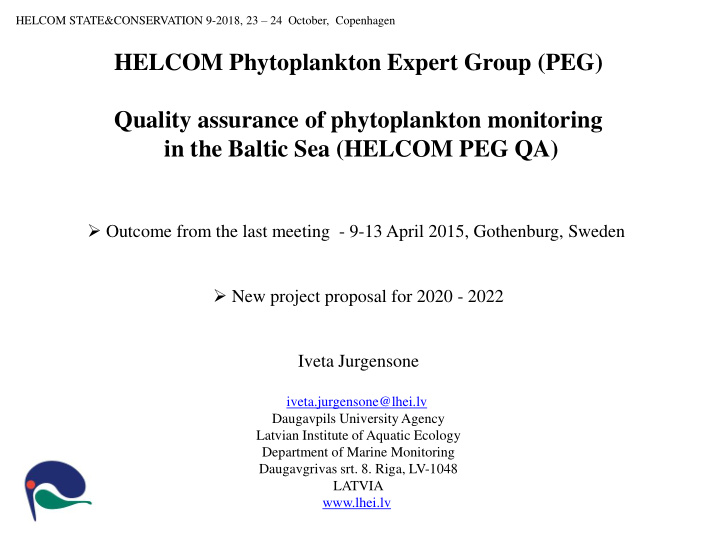



HELCOM STATE&CONSERVATION 9-2018, 23 – 24 October, Copenhagen HELCOM Phytoplankton Expert Group (PEG) Quality assurance of phytoplankton monitoring in the Baltic Sea (HELCOM PEG QA) Outcome from the last meeting - 9-13 April 2015, Gothenburg, Sweden New project proposal for 2020 - 2022 Iveta Jurgensone iveta.jurgensone@lhei.lv Daugavpils University Agency Latvian Institute of Aquatic Ecology Department of Marine Monitoring Daugavgrivas srt. 8. Riga, LV-1048 LATVIA www.lhei.lv
HELCOM STATE&CONSERVATION 9-2018, 23 – 24 October, Copenhagen Practical phytoplankton course: no expert had been invited as a teacher, PEG members taught each other, Update of the Biovolume file: adding of Aphia ID and Aphia-link according to WoRMS updating of species synonyms adding new species and size classes some of species in Biovolume file are not listed in AlgaeBase or WoRMS Updating the HELCOM Guideline for Phytoplankton
HELCOM STATE&CONSERVATION 9-2018, 23 – 24 October, Copenhagen Updating the “Cyanobacteria biomass 1990 - 2017” (Baltic Sea Environmental Fact Sheet) PEG agree to continue updating the fact sheet with data from 2018 Latest information and discussions about the HELCOM Phytoplankton indicator work: Diatom-dinoflagellate index Seasonal succession of dominating phytoplankton groups Cyanobacterial bloom index (CyaBI)
HELCOM STATE&CONSERVATION 9-2018, 23 – 24 October, Copenhagen Harmonization between the HELCOM PEG biovolume file and the CEN standard EN-16695:2015 check the species with the largest differences in biovolume and geometric shapes of cell Image gallery on the Nordic microalgae website the agreed photos (different groups) of the PEG will be uploaded to www.NordicMicroalgae.org by the originators
HELCOM STATE&CONSERVATION 9-2018, 23 – 24 October, Copenhagen Presentation of the German 2016 Phytoplankton ring test ring test organized by the Quality Assurance Panel of the German Marine Monitoring Program of the North Sea and Baltic Sea located at the Federal Environment Agency Presentation of the SYKE Phytoplankton proficiency test Prof Test 12/2017: Baltic Sea and freshwater species identification test organized by Finish Marine Institute (SYKE)
HELCOM STATE&CONSERVATION 9-2018, 23 – 24 October, Copenhagen Additional presentations during the meeting: Presentation of the software Plankton Tool Box by Ann-Turi Skjevik and Marie Johansen from SMHI, Sweden, Extra topic – blood red ice along the Baltic Sea coast winter 2018 by Heidi Hällfors from SYKE, Finland, The distribution of cyanobacteria in the Baltic Proper observed using novel methods in summer 2017 by Bengt Karlson, from SMHI, Sweden, Experiences from analyzing multi-country phytoplankton data downloaded from www.ices.dk by Bengt Karlson, from SMHI, Sweden
HELCOM STATE&CONSERVATION 9-2018, 23 – 24 October, Copenhagen Next meeting in 2018: will be held in in Riga or Daugavpils, Latvia from 8-12 April , training course on diatoms, updating of the Biovolume file, regular tasks.
HELCOM STATE&CONSERVATION 9-2018, 23 – 24 October, Copenhagen Message to HELCOM State and Conservation group: the main focus of the PEG is to improve the quality of phytoplankton monitoring in the Baltic Sea area and to harmonize sampling, analytical methods and analytical skills, it is not clear the phytoplankton guidelines still is a part of the HELCOM Combine manual, how to refer to this and other guidelines at the webpage and the document should contain last update date, PEG continues to provide data to the indicator ” Cyanobacterial Bloom Index (CyaBI) ” , indicators still in development will be discussed in the future if presented at the meeting, PEG asks the money support for participation in the tests like SYKE Prof Test, some of the funding can be used for presentations of ring test results and for additional statistics from the results.
HELCOM STATE&CONSERVATION 9-2018, 23 – 24 October, Copenhagen New project proposal 2020 – 2022 The main activity within the project: training courses, intercalibrations, further unifying the counting method , updating of the biovolume file, harmonization of biovolume calculations between CEN standard EN16695:2015 and the PEG biovolume list, production of environmental fact sheets, platform for phytoplankton indicators.
HELCOM STATE&CONSERVATION 9-2018, 23 – 24 October, Copenhagen The outcome of the project will be: annual reports from the 3 workshops. Annual revised species/biovolume list of Baltic Sea phytoplankton species, updated HELCOM Monitoring manual for Phytoplankton – Species composition, abundance and biomass, will be discuss the existing and possible new phytoplankton indicators, updated HELCOM environmental fact sheet (Cyanobacteria biomass), outcome of the intercalibration results and discussions in the workshop report, continuation of contribution of quality-checked imagines to the HELCOM PEG image gallery at, www.Nordicmicroalgae.org, final report (2020-2022). Suggested host countries for workshops are: Poland in 2020, Sweden in 2021 and Denmark in 2022
Thank you for your attention! Photo from Marléne Johansson , 2018
Recommend
More recommend